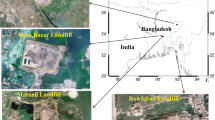Abstract
Gold mining in South Africa resulted in vast volumes of tailings, which have been deposited in impoundments. Poor management of most of the tailings dams resulted in the escape of seepage, adversely affecting soils and water quality. Some tailings dams have been partially or completely reclaimed leaving contaminated footprints. These zones pose a serious threat to the underlying dolomitic aquifers. In this study, the footprints of seven selected sites situated near Johannesburg have been investigated. It was found that the topsoil is highly acidified and only a minor portion of contaminants is bioavailable. However, phytotoxic contaminants such as Co, Ni and Zn could complicate rehabilitation measures as they limit the soil function. In addition, soil samples contain trace element concentrations, which often exceed background concentrations in soils. As a result, the depletion of buffer minerals and the subsequent acidification could result in the long-term remobilization of large quantities of contaminants into the groundwater. Soil management measures such as liming are required to prevent the contaminant migration from the topsoil into the subsoil and groundwater as well as to provide suitable recultivation conditions to enable future land use.
Résumé
Les exploitations d'or en Afrique du Sud s'accompagnent de la production de grands volumes de déchets stockés dans des digues à stériles. Un contrôle insuffisant de la plupart de ces digues à stériles a pour conséquence des fuites qui affectent la qualité des sols et des eaux souterraines. Quelques digues à stériles ont été partiellement, ou totalement remises en état, laissant cependant des taches de contamination. Ces zones représentent une menace sérieuse pour les aquifères dolomitiques sous-jacents. Dans cette étude, les taches de contamination de sept sites sélectionnés près de Johannesburg ont étéétudiées. On a trouvé que le sol de surface est fortement acidifié et seulement une faible proportion de polluants est bien dégradable. Des polluants toxiques pour la végétation, tels que cobalt et nickel, pourraient compliquer les mesures de réhabilitation dans la mesure où ils altèrent les fonctions d'épuration des sols. De plus, les sols contiennent des concentrations d'é1éments traces, qui dépassent souvent les concentrations régionales des zones non polluées. En conséquence, la libération de minéraux tampons et l'acidification résultante pourraient conduire à une remobilisation, sur le long terme, de grandes quantités de polluants dans les eaux souterraines.
Similar content being viewed by others
Author information
Authors and Affiliations
Additional information
Received: 20 April 1999 · Accepted: 27 September 1999
Rights and permissions
About this article
Cite this article
Rösner, T., van Schalkwyk, A. The environmental impact of gold mine tailings footprints in the Johannesburg region, South Africa. Bull Eng Geol Env 59, 137–148 (2000). https://doi.org/10.1007/s100640000037
Issue Date:
DOI: https://doi.org/10.1007/s100640000037




